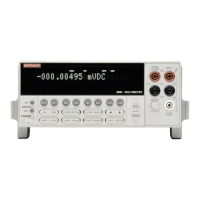IEEE-488 Reference
4-144
Defaults Power-up Saved power-on setup
*RST ±1% for DCI, DCV, Ω2 and Ω4
±5% for ACI and ACV
:SYSTem:PRESet Same as *RST
Query :NTOLerance? Query noise tolerance
:NTOLerance? DEFault Query *RST default noise tolerance
:NTOLerance? MINimum Query lowest allowable noise tolerance
:NTOLerance? MAXimum Query largest allowable noise tolerance
Short-form formats: :curr:ac:aver:adv:ntol?
:curr:ac:aver:adv:ntol? xxx
:curr[:dc]:aver:adv:ntol?
:curr[:dc]:aver:adv:ntol? xxx
:volt:ac:aver:adv:ntol?
:volt:ac:aver:adv:ntol? xxx
:volt[:dc]:aver:adv:ntol?
:volt[:dc]:aver:adv:ntol? xxx
:res:aver:adv:ntol?
:res:aver:adv:ntol? xxx
:fres:aver:adv:ntol?
:fres:aver:adv:ntol? xxx
Response message: 0 to 100 (±%)
Description Each measurement function (except TEMP and FREQ) can utilize the advanced filter which
adds a noise tolerance window to the averaging algorithm. These commands are used to set the
noise tolerance level of the advanced filter for the specifed function. The :ADVanced[:STATe]
commands are used to enable or disable the advanced filter.
The noise tolerance level is expressed as a percent of the last averaged reading. In general, if the
noise is within this window, the reading is simply based on the normal averaging algorithm. If a
reading is outside this window, then the advanced averaging algorithm is used. See Section 3 for
details.
Programming example 10 OUTPUT 716; “:curr:ac:aver:adv:ntol 20; ntol?”
20 ENTER 716; A$
30 PRINT A$
40 END
Line 10 Sets the noise tolerance to ±20%, and then queries the noise tolerance level.
Line 20 Addresses the Model 2001 to talk.
Line 30 Displays the noise tolerance band (20).

